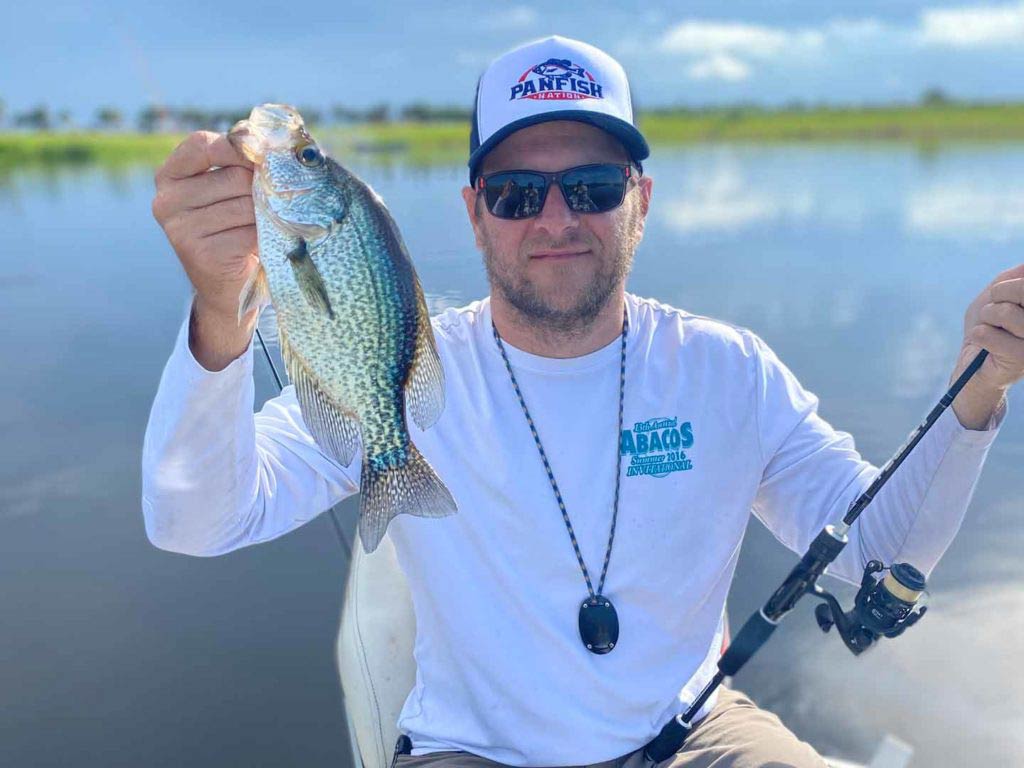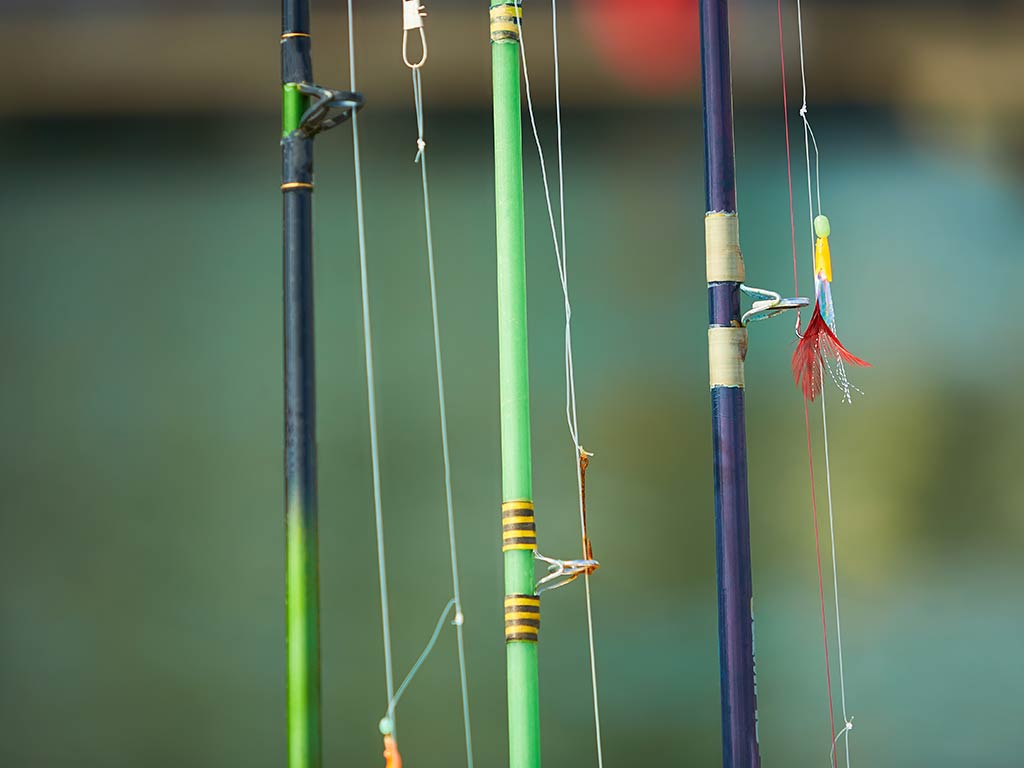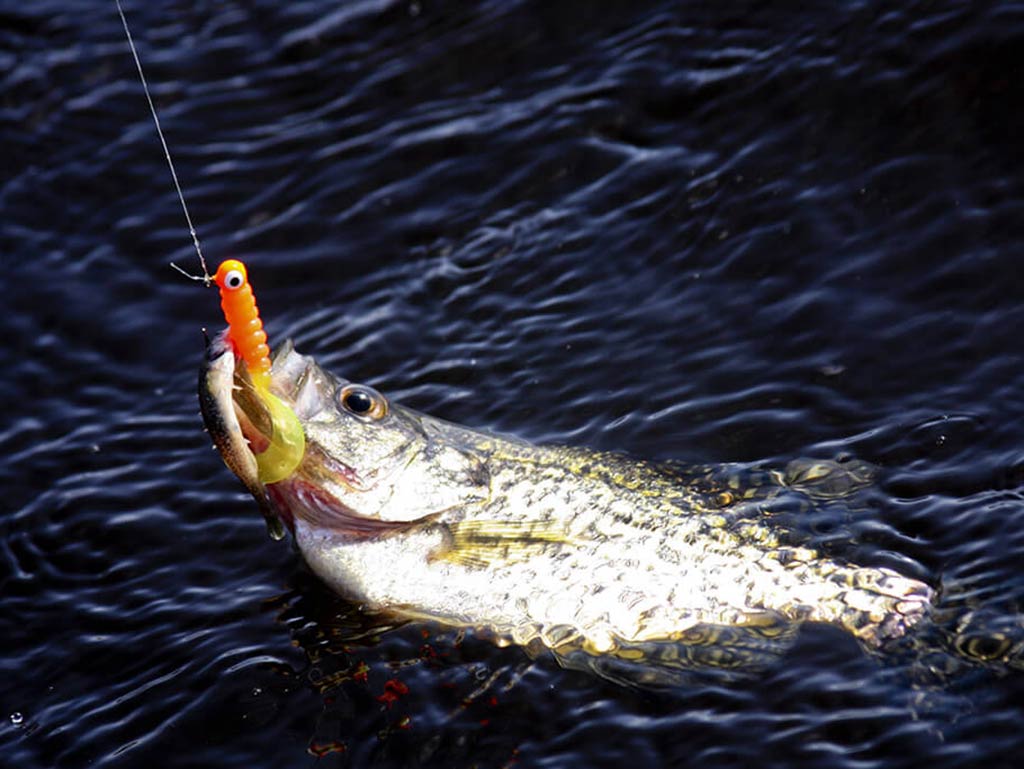Everyone’s favorite starter fish, Crappie, is a delight for anglers across the continent. Small, delicious, and numerous, they’re a staple of the recreational fishing scene. But what about the best Crappie fishing lines?

You can generally catch Crappie on simple tackle with finesse techniques. While they can put a bend in ultralight rods, it’s not often that one breaks a line. That said, line choice is extremely important for a number of reasons. It helps with control, camouflage, and is responsible for securing your hook while preventing breaking and lost fish.
In this article, we’ll discuss the basic line options and why each warrants consideration for Crappie-specific fishing rigs.
Crappie Fishing Line Materials

Some Crappie anglers carry multiple rods and reels spooled with different lines because each line is designated for specific techniques and situations. However, these tend to be very serious Crappie anglers who are targeting the fish regularly. For the majority of us, carrying one rod and line type is sufficient. Here are your options:
- Braid. The most sensitive and versatile line. Braided lines cast extremely well, are sensitive, and have a small diameter. That means you can stack more line on a small spool without stepping down strength. Sometimes, that extra line comes in handy for deeper jigging and long casts. Braid is excellent for all-around Crappie fishing.
- Fluorocarbon. This is a strong and durable option. Most fluoro is a little on the stiffer side but, when fished in light line classes, it’s sensitive enough. The line also offers great camouflage and is a good choice when fish are spooky.
- Monofilament. Mono is durable, supple, and a favorite line for many anglers. It’s also affordable and will hold its own against any other line type in terms of performance. While mono lines can stretch against sudden and heavy pressure, this is rarely an issue when targeting Crappie.
Best Techniques by Line Style

You can fish just about any technique with any of the major three line types. There are some nuances to each line style, however, that make them best suited to different techniques. Braid and monofilament are best for casting and finesse hook sets. They’re effective in the ultralight category, with monofilament being able to go all the way down to 2 pounds.
Monofilament and fluorocarbon are ideal for pegging and slip bobbers. They cast better and have less risk of wrapping and tangling. Bobber rigs work well on braid but if they do tangle, it can quickly become a disaster. That’s why most anglers prefer braid for casting and jigging.
All of the line types work well for ice fishing but fluorocarbon is the leading favorite for resiliency through the ice. Braided lines can ice up and mono is soft with more stretch. Myn top tip is to go fluoro when the mercury dips.
Choosing the Right Fishing Line Test for Crappie

Line type is important but it’s also a determination made based on your chosen fishing style and personal preference. The test of that line might be more important as this determines the size of the tackle and the fishing technique used.
For heavy trolling and deep jigging, running the 10–12 lb test range is great. Some anglers go heavier, using 20 pounds for the primary line and stepping down to a lighter leader. This is also a great move for high-line stress techniques and waters with especially large fish. Err on the heavier side if you might cross over and encounter other species as well.
For shallow-water casting and jigging, dropping to 8 pounds or less test is normal. When I fish ponds and smaller waters, dropping to 4 lb test is just fine. The lighter line cuts through water easier and it’s extra sensitive for great hook sets and a fun fight.
Best Crappie Spots

Now that you have the right line, it’s time to hunt down some big Crappie! You won’t find a better tasting fish in freshwater and, with generous limits in many areas, this is a species worth investing the time to learn and understand.
- Southern States. Crappie fishing is like a religion in the southern states. Head to Alabama, Tennessee, Texas, Mississippi, or push into the Midwest in places like Oklahoma for excellent opportunities. Reservoirs with flooded timber make for an ideal habitat and you’ll find plenty of big fish in these waters.
- Upper Midwest. Some of the largest fish anglers encounter come from the Great Lakes region. Much like the South, Crappie fishing is a serious business in the upper Midwest. Anglers hit them hard in the spring and fall, and also spend significant efforts targeting Crappie through the ice. Crappie in extremely cold waters produce excellent meat.
- Western States. The distribution of Crappie is extensive and the western states are full of lakes and rivers with fish. Northern California is a hotspot and you’ll find Crappie in many of the famous Bass fisheries. Nevada, Idaho, Arizona, and pretty much every state in the West offers fisheries with strong Crappie populations.
- Canada. Extending north from the Great Lakes, Ontario is a major hotspot. The province has a seemingly endless string of lakes and many of them have great numbers and big fish. You can find great fishing throughout many other Canadian regions as well.
Crappie Fishing Line FAQs
Which Crappie line will you choose?

The beauty of Crappie fishing is the simplicity of the fishing style. Most days, you can pin a bobber or jig over schools of fish. Any line is capable of the simple fishing styles and rigging that run directly to a hook. For most anglers, start with a basic mono or fluoro line. As you gain experience, add a second rod rigged with braid for casting and finesse fishing.
What lines are you using to catch Crappie? Tell us about your favorites and how they pair with different techniques in the comments below!
